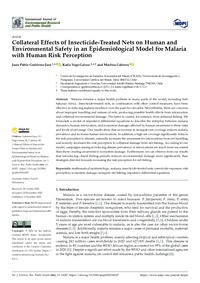Mostrar el registro sencillo de la publicación
Collateral effects of insecticide-treated nets on human and environmental safety in an epidemiological model for malaria with human risk perception
| dc.contributor.author | Gutiérrez-Jara, Juan P. | |
| dc.contributor.author | Vogt-Geisse, Katia | |
| dc.contributor.author | Cabrera, Maritza Guadalupe | |
| dc.date.accessioned | 2023-01-03T19:07:36Z | |
| dc.date.available | 2023-01-03T19:07:36Z | |
| dc.date.issued | 2022 | |
| dc.identifier.uri | http://repositorio.ucm.cl/handle/ucm/4325 | |
| dc.description.abstract | Malaria remains a major health problem in many parts of the world, including Sub-Saharan Africa. Insecticide-treated nets, in combination with other control measures, have been effective in reducing malaria incidence over the past two decades. Nevertheless, there are concerns about improper handling and misuse of nets, producing possible health effects from intoxication and collateral environmental damage. The latter is caused, for instance, from artisanal fishing. We formulate a model of impulsive differential equations to describe the interplay between malaria dynamics, human intoxication, and ecosystem damage; affected by human awareness to these risks and levels of net usage. Our results show that an increase in mosquito net coverage reduces malaria prevalence and increases human intoxications. In addition, a high net coverage significantly reduces the risk perception to disease, naturally increases the awareness for intoxications from net handling, and scarcely increases the risk perception to collateral damage from net fishing. According to our model, campaigns aiming at reducing disease prevalence or intoxications are much more successful than those creating awareness to ecosystem damage. Furthermore, we can observe from our results that introducing closed fishing periods reduces environmental damage more significantly than strategies directed towards increasing the risk perception for net fishing. | es_CL |
| dc.language.iso | en | es_CL |
| dc.rights | Atribución-NoComercial-SinDerivadas 3.0 Chile | * |
| dc.rights.uri | http://creativecommons.org/licenses/by-nc-nd/3.0/cl/ | * |
| dc.source | International Journal of Environmental Research and Public Health, 19(23), 16327 | es_CL |
| dc.subject | Mathematical epidemiology | es_CL |
| dc.subject | Malaria | es_CL |
| dc.subject | Insecticide-treated nets | es_CL |
| dc.subject | Insecticide exposure | es_CL |
| dc.subject | Risk perception | es_CL |
| dc.subject | Ecosystem damage | es_CL |
| dc.subject | Mosquito net fishing | es_CL |
| dc.subject | Impulsive differential equations | es_CL |
| dc.title | Collateral effects of insecticide-treated nets on human and environmental safety in an epidemiological model for malaria with human risk perception | es_CL |
| dc.type | Article | es_CL |
| dc.ucm.indexacion | Scopus | es_CL |
| dc.ucm.indexacion | Isi | es_CL |
| dc.ucm.uri | mdpi.com/1660-4601/19/23/16327 | es_CL |
| dc.ucm.doi | doi.org/10.3390/ijerph192316327 | es_CL |



